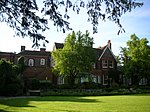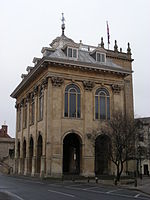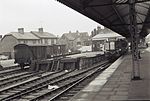Abingdon Bridge

Abingdon Bridge crosses the River Thames at the town of Abingdon, Oxfordshire, England. It carries the A415 road from Abingdon to Dorchester, Oxfordshire, over the reach of the Thames between Culham Lock and Abingdon Lock. The bridge is actually two bridges, linked by Nag's Head Island. Abingdon Bridge is the northern part towards the town which has six arches and crosses the backwater and mill stream. The southern part is technically called Burford Bridge and has one main arch and four minor arches at the river and two minor arches on the floodplain. This crosses the main navigation channel. Furthermore, to complete the Thames crossing, Culham Bridge crossing the Swift Ditch should also be considered as an extension.
Excerpt from the Wikipedia article Abingdon Bridge (License: CC BY-SA 3.0, Authors, Images).Abingdon Bridge
Bridge Street, Vale of White Horse Caldecott
Geographical coordinates (GPS) Address External links Nearby Places Show on map
Geographical coordinates (GPS)
| Latitude | Longitude |
|---|---|
| N 51.6686 ° | E -1.2795 ° |
Address
Bridge Street
Bridge Street
OX14 3HX Vale of White Horse, Caldecott
England, United Kingdom
Open on Google Maps








